Abstract
Tar bitumens are increasingly being used as a binder in road works. They consist of a standard product of about 70% bitumen and 25-30% tar. Tar bitumens are classifiable as the pyrolysis products of organic materials and are applied hot. Depending on the temperature used there are emissions of various intensities of polycyclic aromatic hydrocarbons (PAH), some of which are carcinogenic. A total of 250 one hour air samples was taken at breathing height on 20 days at 11 road works sites. The region of road paving operations in the immediate neighbourhood of the finishing machine operator and the screedmen were the chosen sampling points. A total of 19 unsubstituted chromatography/mass spectrometry. These included benzo[b]fluoranthene, benzo[a]pyrene, chrysene, dibenzo[a,h]anthracene, and indeno[1,2,3-cd]pyrene, all of which are carcinogenic. The median concentrations of chrysene and of benzo[b,j + k] fluoranthenes (determined en masse) were 9.3 and 2.8 micrograms/m3 respectively. The median concentrations of benzo[a]pyrene (BaP) and indeno[1,2,3,-cd]pyrene were 0.7 and 0.2 micrograms/m3 respectively. Dibenzo[a,h]anthracene had the lowest median concentration with about 0.03 micrograms/m3. Of the resulting shift means, the BaP concentration was over 1 microgram/m3 in about 50% of the cases, over 2 micrograms/m3 in 35%, and over 5 micrograms/m3 in about 15%. Even when the temperature of the paving mix was only between 120 degrees and 135 degrees C. 4.8% of the concentrations (identical to 3 samples) were greater than 2 micrograms BaP/m3, this value was exceeded in 34.9% of the determinations (identical to 30 samples) when the temperature of the tar bitumen was between 135 degrees and 150 degrees C. The highest concentration measured here was 17.8 micrograms BaP/m3. The recommended maximum paving temperature of the paving mix of 150 degrees C was exceeded in about 23% of all cases. The maximum concentration determined under any condition was 22 microgram/m(3). Thus the employment of tar bitumen as a binding material during road paving operations must be regarded as causing a considerable risk to health. The primary task is to ascertain whether tar bitumen can be replaced as a binder in paving for roads and what safety measures are practicable.
Full text
PDF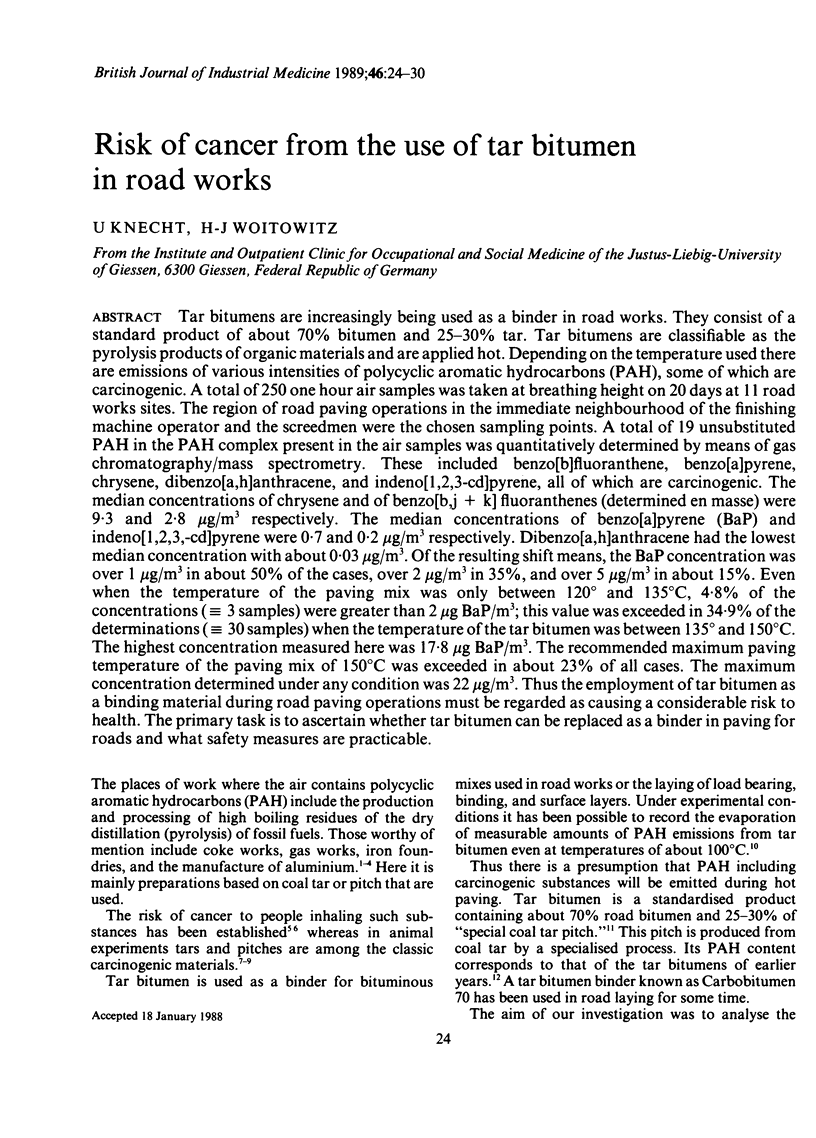
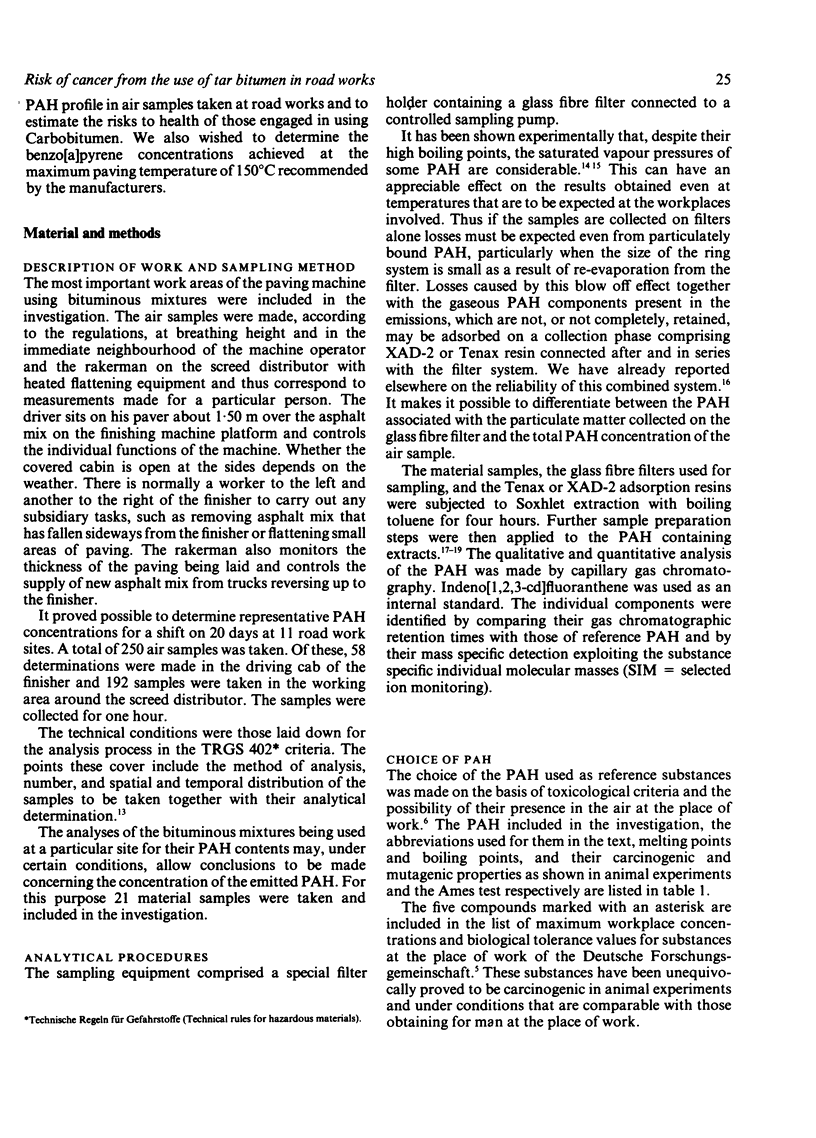
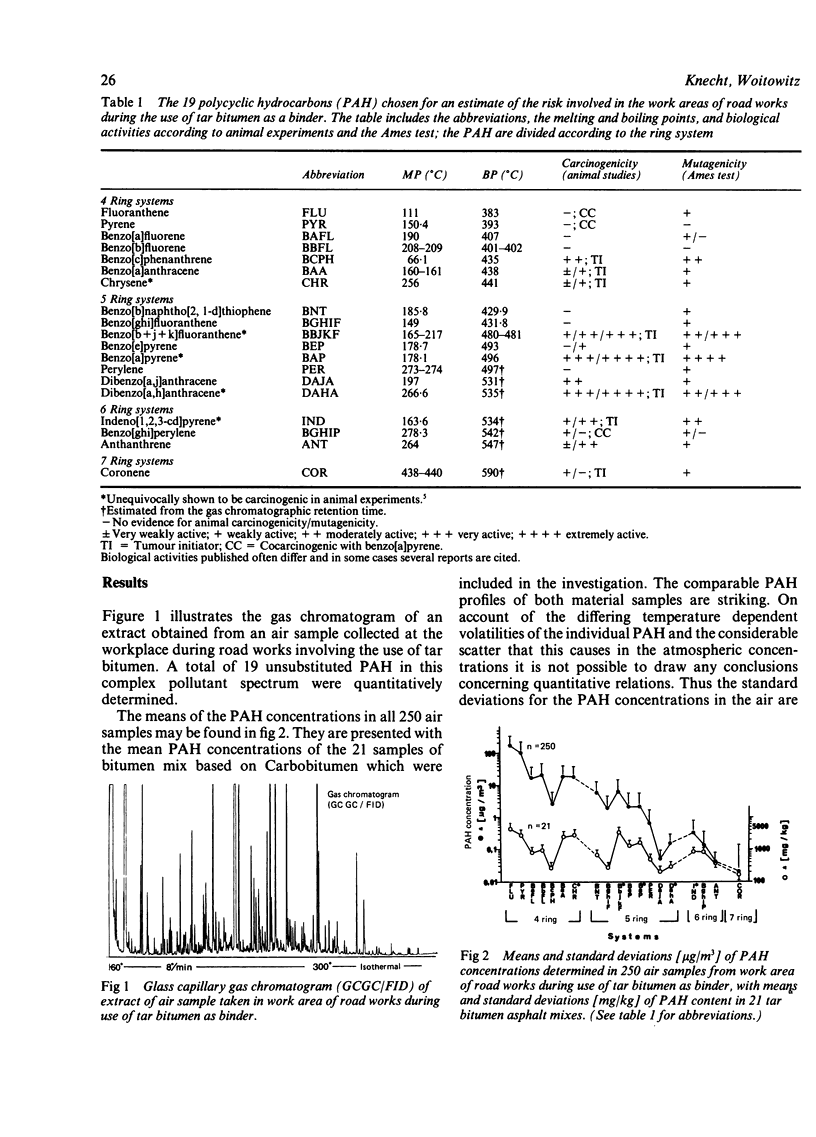
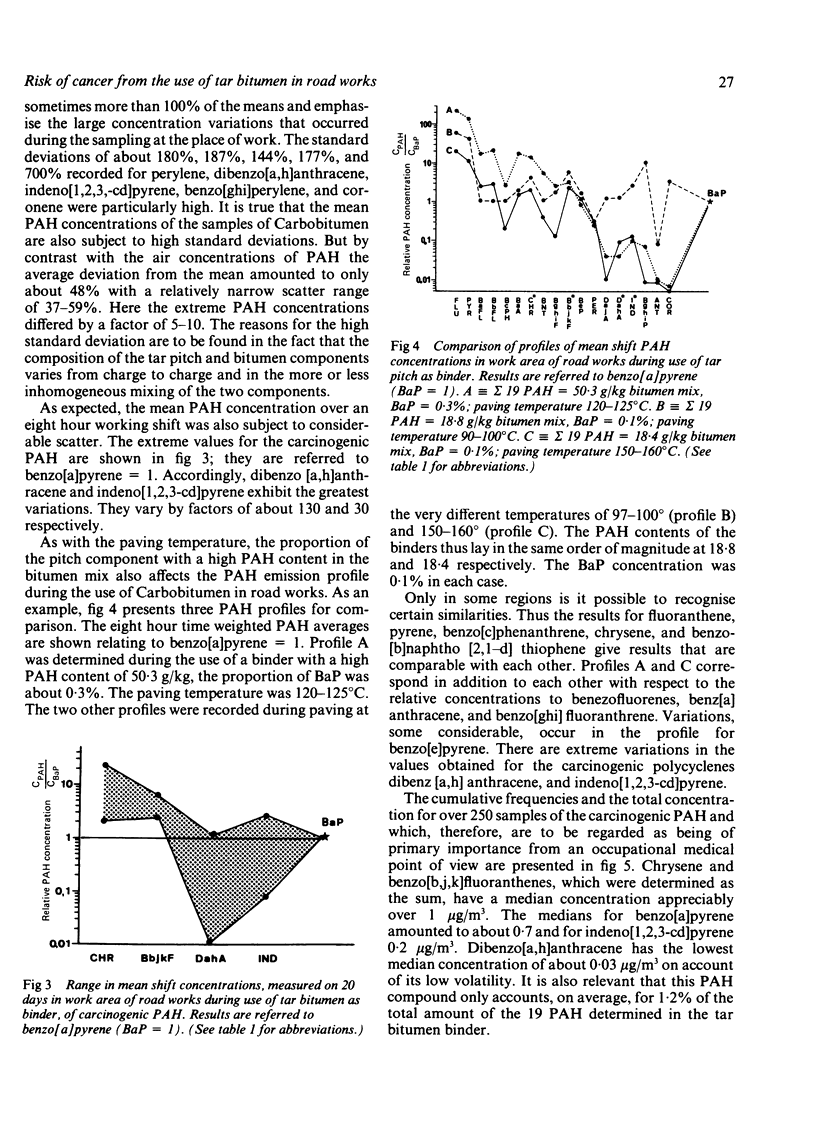

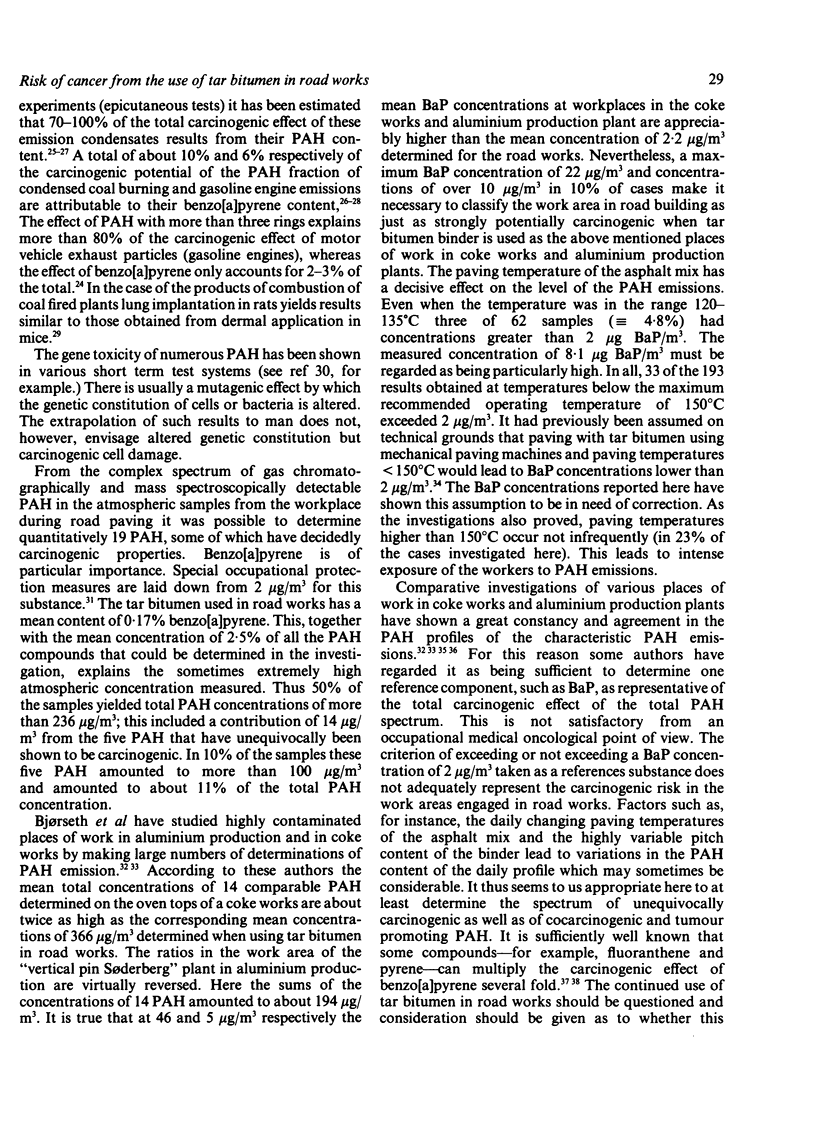
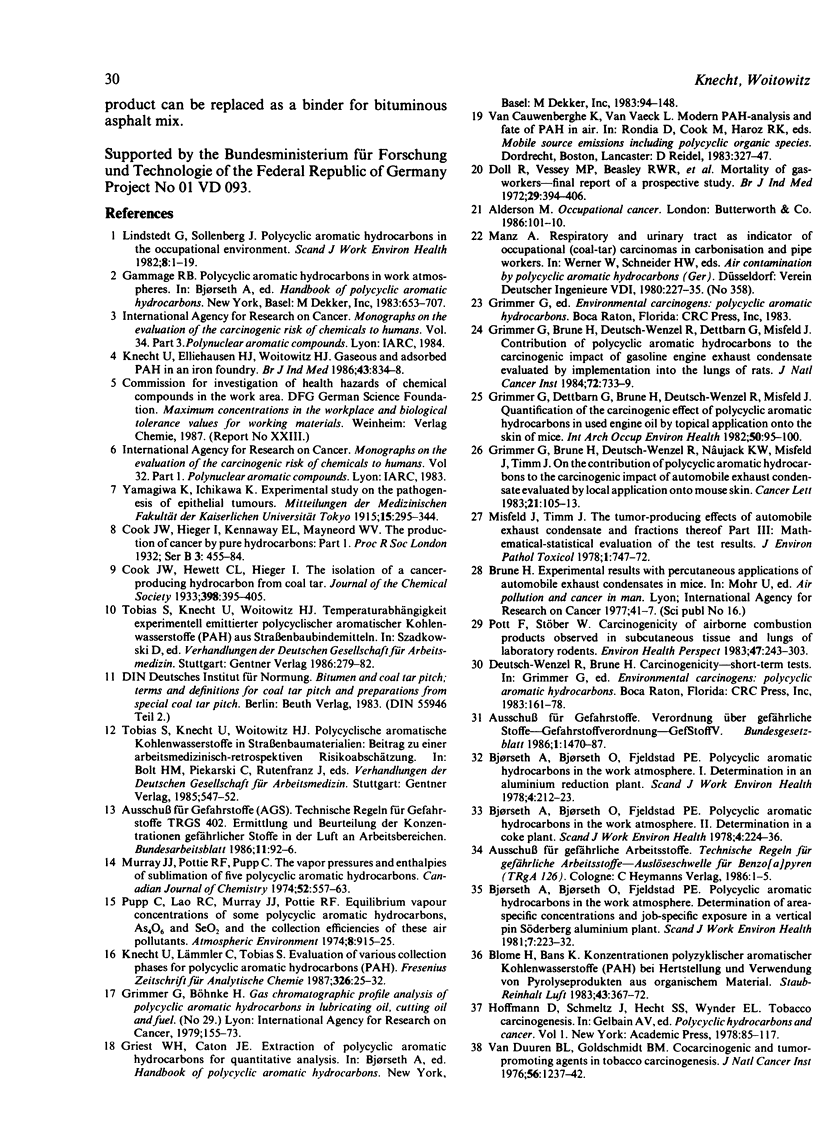
Selected References
These references are in PubMed. This may not be the complete list of references from this article.
- Bjøorseth A., Bjørseth O., Fjeldstad P. E. Polycyclic aromatic hydrocarbons in the work atmosphere. II. Determination in a coke plant. Scand J Work Environ Health. 1978 Sep;4(3):224–236. doi: 10.5271/sjweh.2703. [DOI] [PubMed] [Google Scholar]
- Doll R., Vessey M. P., Beasley R. W., Buckley A. R., Fear E. C., Fisher R. E., Gammon E. J., Gunn W., Hughes G. O., Lee K. Mortality of gasworkers - final report of a prospective study. Br J Ind Med. 1972 Oct;29(4):394–406. doi: 10.1136/oem.29.4.394. [DOI] [PMC free article] [PubMed] [Google Scholar]
- Grimmer G., Brune H., Deutsch-Wenzel R., Dettbarn G., Misfeld J. Contribution of polycyclic aromatic hydrocarbons to the carcinogenic impact of gasoline engine exhaust condensate evaluated by implantation into the lungs of rats. J Natl Cancer Inst. 1984 Mar;72(3):733–739. [PubMed] [Google Scholar]
- Grimmer G., Brune H., Deutsch-Wenzel R., Naujack K. W., Misfeld J., Timm J. On the contribution of polycyclic aromatic hydrocarbons to the carcinogenic impact of automobile exhaust condensate evaluated by local application onto mouse skin. Cancer Lett. 1983 Nov;21(1):105–113. doi: 10.1016/0304-3835(83)90089-7. [DOI] [PubMed] [Google Scholar]
- Grimmer G., Dettbarn G., Brune H., Deutsch-Wenzel R., Misfeld J. Quantification of the carcinogenic effect of polycyclic aromatic hydrocarbons in used engine oil by topical application onto the skin of mice. Int Arch Occup Environ Health. 1982;50(1):95–100. doi: 10.1007/BF00432496. [DOI] [PubMed] [Google Scholar]
- Knecht U., Elliehausen H. J., Woitowitz H. J. Gaseous and adsorbed PAH in an iron foundry. Br J Ind Med. 1986 Dec;43(12):834–838. doi: 10.1136/oem.43.12.834. [DOI] [PMC free article] [PubMed] [Google Scholar]
- Lindstedt G., Sollenberg J. Polycyclic aromatic hydrocarbons in the occupational environment: with special reference to benzo[a]pyrene measurements in Swedish industry. Scand J Work Environ Health. 1982 Mar;8(1):1–19. doi: 10.5271/sjweh.2503. [DOI] [PubMed] [Google Scholar]
- Misfeld J., Timm J. The tumor-producing effect of automobile exhaust condensate and fractions thereof. Part III: mathematical-statistical evaluation of the test results. J Environ Pathol Toxicol. 1978 Jul-Aug;1(6):747–771. [PubMed] [Google Scholar]
- Pott F., Stöber W. Carcinogenicity of airborne combustion products observed in subcutaneous tissue and lungs of laboratory rodents. Environ Health Perspect. 1983 Jan;47:293–303. doi: 10.1289/ehp.8347293. [DOI] [PMC free article] [PubMed] [Google Scholar]
- Pupp C., Lao R. C., Murray J. J., Pottie R. F. Equilibrium vapour concentrations of some polycyclic aromatic hydrocarbons, As4O6 and SeO2 and the collection effiencies of these air pollutants. Atmos Environ. 1974 Sep;8(9):915–925. doi: 10.1016/0004-6981(74)90081-x. [DOI] [PubMed] [Google Scholar]
- Van Duuren B. L., Goldschmidt B. M. Cocarcinogenic and tumor-promoting agents in tobacco carcinogenesis. J Natl Cancer Inst. 1976 Jun;56(6):1237–1242. doi: 10.1093/jnci/56.6.1237. [DOI] [PubMed] [Google Scholar]


